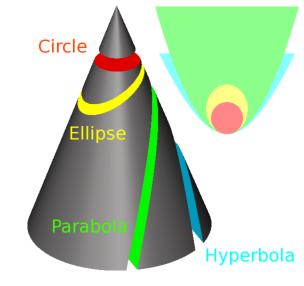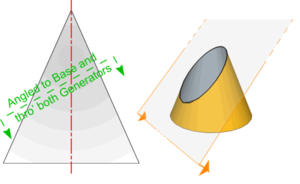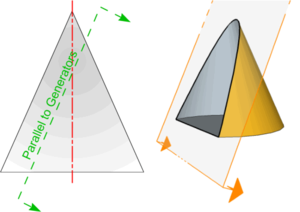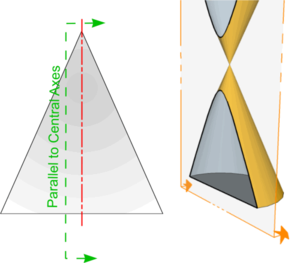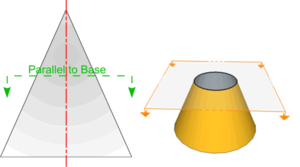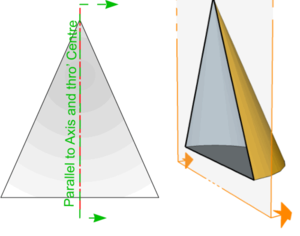Conic Sections: Difference between revisions
From DT Online
m (Added text and links) |
(First draft of completed article) |
||
| Line 15: | Line 15: | ||
| <span style="color:#B00000"> | | <span style="color:#B00000"> | ||
* The curve produced when a secton is taken across a right circular cone at an angle to the base circle, and intersecting the generators on both sides. | * The curve produced when a secton is taken across a right circular cone at an angle to the base circle, and intersecting the generators on both sides. | ||
* Ellipses are a ''closed curve'' with a ''Major Axis'' and a ''Minor Axis''. | |||
* An Ellipse is also the result of taking a section across a [https://en.wikipedia.org/wiki/Cylinder_%28geometry%29 '''Cylinder'''] at at angle to its base. | * An Ellipse is also the result of taking a section across a [https://en.wikipedia.org/wiki/Cylinder_%28geometry%29 '''Cylinder'''] at at angle to its base. | ||
* Ellipses describe the orbits of planets and the curve has been used to design [https://en.wikipedia.org/wiki/Arch Arch Bridges]. | |||
| [[File:Conics-ElipseTrans.png| | * Ellipses can be drawn as '''[[Loci]]''' with an '''[[Conics|Eccentricity]]''' of less than 1 ''(i.e. the Locus of all points where the ratio of distances from its '''[[Conics|Focus]]''' and '''[[Conics|Directrix]]''' are a constant which is less than 1)'' | ||
| [[File:Conics-ElipseTrans.png|300px|right]] | |||
|- | |- | ||
| '''[[Parabola]]''' | | '''[[Parabola]]''' | ||
| <span style="color:#B00000"> | | <span style="color:#B00000"> | ||
* The curve produced when a secton is taken through a right circular cone parallel to the generator | * The curve produced when a secton is taken through a right circular cone parallel to the generator. | ||
| [[File:Conics-ParabolaTrans.png | | * A Parabola describes the path taken by a object thrown into the air and the curve has been used to design [https://en.wikipedia.org/wiki/Arch Arch Bridges]. | ||
* Parabolas can be drawn as '''[[Loci]]''' with an '''[[Conics|Eccentricity]]''' equal to 1 ''(i.e. the Locus of all points where the ratio of distances from its '''[[Conics|Focus]]''' and '''[[Conics|Directrix]]''' are a constant which is equal to 1)'' | |||
| [[File:Conics-ParabolaTrans.png |300px|right]] | |||
|- | |- | ||
| ''' | | [https://en.wikipedia.org/wiki/Hyperbola '''Hyperbola'''] | ||
| <span style="color:#B00000"> | | <span style="color:#B00000"> | ||
* The curve produced when a secton is taken | * The curve produced when a secton is taken which cuts both parts of a Double Cone but does not pass through the Apex ''(e.g. parallel to Axis as shown)'' - note that with a Double Cone, two Hyperbolae are created. | ||
| [[File:Conics-HyperbolaTrans.png| | * Hyperbolae describe the paths taken by non-orbiting comets or the shadow cast on a sun dial for example. | ||
* An Hyperbola can be drawn as a '''[[Loci|Locus]]''' with an '''[[Conics|Eccentricity]]''' greater than 1 ''(i.e. the Locus of all points where the ratio of distances from its '''[[Conics|Focus]]''' and '''[[Conics|Directrix]]''' are a constant which is greater than 1)'' | |||
| [[File:Conics-HyperbolaTrans.png|300px|right]] | |||
|- | |- | ||
| ''' | | [https://en.wikipedia.org/wiki/Circle '''Circle'''] | ||
| <span style="color:#B00000"> | | <span style="color:#B00000"> | ||
* The curve produced when a secton is taken across a right circular cone parallel to the base circle. | * The curve produced when a secton is taken across a right circular cone parallel to the base circle. | ||
* The circle can be considered as a fourth type of conic section ''(as it was by [https://en.wikipedia.org/wiki/Apollonius_of_Perga '''Apollonius'''])'' or as a special case of ellipse. | * The circle can be considered as a fourth type of conic section ''(as it was by [https://en.wikipedia.org/wiki/Apollonius_of_Perga '''Apollonius'''])'' or as a special case of ellipse. | ||
* The part of a cone ''(or | * The part of a cone ''(or [https://en.wikipedia.org/wiki/Pyramid_%28geometry%29 '''Pyramid'''])'' lying between two parallel planes such as this is called the [https://en.wikipedia.org/wiki/Frustum '''Frustrum'''] | ||
| [[File:Conics-Circle.png | | | [[File:Conics-Circle.png |300px|right]] | ||
|- | |- | ||
| ''' | | [https://en.wikipedia.org/wiki/Triangle '''Triangle'''] | ||
| <span style="color:#B00000"> | | <span style="color:#B00000"> | ||
* Included for completeness, triangles are created when a section is taken through the Apex and across the Base Cicle diameter. | * Included for completeness, triangles are created when a section is taken through the Apex and across the Base Cicle diameter. | ||
* Either an [https://en.wikipedia.org/wiki/Isosceles_triangle '''Isosceles'''] or [https://en.wikipedia.org/wiki/Equilateral_triangle '''Equilaterial Triangle'''] is revealed when a Right Cone is halved in this way. Other triangles would result from similar sectioning of an Oblique Cone. | * Either an [https://en.wikipedia.org/wiki/Isosceles_triangle '''Isosceles'''] or [https://en.wikipedia.org/wiki/Equilateral_triangle '''Equilaterial Triangle'''] is revealed when a Right Cone is halved in this way. Other triangles would result from similar sectioning of an Oblique Cone. | ||
| [[File:Conics-TriangleTrans.png| | | [[File:Conics-TriangleTrans.png|300px|right]] | ||
|} | |} | ||
Revision as of 10:17, 5 April 2015
A Cone can be described as the Locus of all lines joining points on the circumference of a ‘Base Circle’ to a point, or ‘Apex’, above it. If the Apex lies perpendicularly above the centre of the base circle it is known as a ‘right cone’ and if not, it is an ‘oblique cone’.
A right circular cone is a Solid of Revolution and can be produced by rotating a right angle triangle around one of the sides opposite its hypotenuse. The hypotenuse generates the surface of a cone as it sweeps round the central ‘Axis’. Any line joining the Apex to the Base Circle is known as a ‘Generator’. Generators can continue through the Apex to produce a second cone opposite to the first, creating a ‘Double Cone,’ and each Cone could extend beyond he Base Circles to infinity.
A right circular cone can be sliced across in various ways to produce a number of Conic Sections. These are curves with particular mathematical properties and which are used in engineering design - e.g. cam profiles and arch bridge design.
| Ellipse |
|
|
| Parabola |
|
|
| Hyperbola |
|
|
| Circle |
|
|
| Triangle |
|
